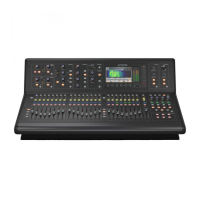Graphic EQ:
A form of EQ that has a number of
faders for controlling the gain of the audio signal.
The faders are set at frequency bands that are
evenly-spaced according to octaves.
GUI:
Abbreviation for ‘graphical user interface’.
GUI channel strip:
Right section of a GUI screen
that represents the processing area of the input or
output channel strip selected to the control
surface.
GUI menu:
A menu selectable at either GUI screen
by clicking the home button (upper-left corner).
GUI screen:
One of the M32’s two screens, which
comprise the GUI.
H
HPF:
Abbreviation for ‘high pass filter’. A filter that
removes lower frequencies from a signal, leaving the
higher frequencies unaffected.
Hum:
Undesirable low frequency tone present in a
signal due to grounding problems or proximity to a
power source.
Hz:
Symbol for ‘Hertz’. A unit of frequency equal to
one cycle of a sound wave per second.
I
I zone:
Area on the master bay that contains
the operator-assignable effects controls.
I/O:
Abbreviation for ‘input/output’.
ID:
Abbreviation for ‘identification’.
Ident:
Scale marking, or gradation, around a
control knob to help indicate the current setting
and to assist in accurate adjustment.
Impedance (Z):
Opposition to the flow of
alternating current in a circuit, measured in ohms.
K
Kernel:
For computers, the kernel is the central
component of most operating systems.
L
LCD select button:
LCD button in the input fast
strips and VCA groups, used for channel/group
navigation and selection, and operator feedback.
LFE:
Abbreviation for ‘low frequency effects’.
Typically, the ‘.1’ in ‘5.1 surround’ is an LFE channel.
LFO:
1. Abbreviation for Low-Frequency Oscillation, an
electronic signal which is usually below 20 Hz and
creates a rhythmic pulse or sweep. This pulse or sweep
is often used to modulate synthesizers, delay lines and
other audio equipment in order to create effects used in
the production of electronic music. 2. Abbreviation for
Low-Frequency Oscillator, the device itself which
produces low-frequency oscillation.
Linux:
Also known as ‘Linux kernel’. Operating
system kernel used by a family of Unix-like
operating systems. See kernel.
LS:
Abbreviation for ‘left surround’. The
left rear speaker in a 5.1 surround system.
M
MADI:
Abbreviation for ‘multi-channel audio digital interface’.
Master bay:
Control area for masters, automation, comms,
monitoring etc. Also contains the primary navigation zone.
Masters:
The three master channels (mono and stereo left and
right) in the master bay.
MB:
Abbreviation for ‘megabyte’.
MC:
Abbreviation for ‘master controller’.
Meter:
Visual device to indicate the level of a signal.
Meters screen:
One of the GUI screens. This is the default
screen of the master bay.

